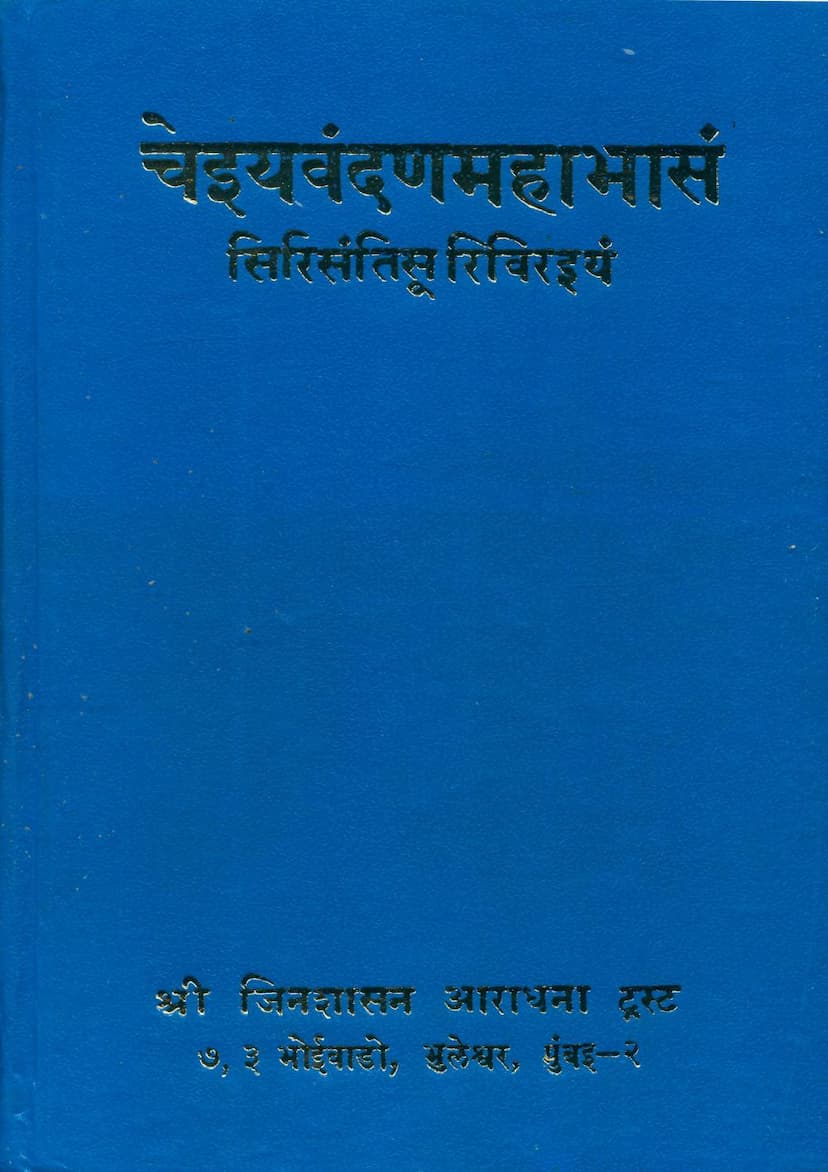Chaiyavandanmahabhasam
Added to library: September 1, 2025

Summary
Here's a comprehensive summary of the Jain text "Chaiyavandanmahabhasam" by Shantisuri, based on the provided pages:
Book Title: Chaiyavandanmahabhasam (चेइयवंदणमहाभासं) Author: Shantisuri (सिरिसंतिसूरिविरइयं) Publisher: Jinshasan Aradhana Trust (श्री जिनशासन आराधना ट्रस्ट) Catalog Link: https://jainqq.org/explore/002267/1
Overall Summary:
"Chaiyavandanmahabhasam" is a profound Jain text authored by Acharya Shantisuri. Published by the Jinshasan Aradhana Trust, it is a comprehensive treatise dedicated to the practice and significance of Chaitya Vandan (worship of Jina idols and temples) within Jainism. The text emphasizes that Chaitya Vandan is the root of Dharma, leading to the generation of auspicious thoughts, the destruction of karmas, and ultimately, the attainment of salvation and all-round welfare.
The book delves deeply into the philosophical underpinnings of Chaitya Vandan, explaining how it helps overcome negative passions (kashayas), purifies the soul, and is a crucial means for spiritual progress. It elaborates on the virtues and glories of the Tirthankaras and Arihants, highlighting their benevolent nature and their role in guiding souls towards liberation. The text also meticulously details the correct methods and procedures for performing Chaitya Vandan, explaining the meaning and significance of various mantras and rituals involved.
Key Themes and Content:
-
Significance of Chaitya Vandan: The central theme is the supreme importance of Chaitya Vandan. It is presented as the most effective means to eliminate impure thoughts (ashubh bhavas) and cultivate pure thoughts (shubh bhavas), which are essential for spiritual advancement and liberation (moksha). The text quotes scriptures like "Lalitavistara" stating that Chaitya Vandan purifies the mind, leading to the destruction of karmas and the attainment of all blessings.
-
Nature of Karma and Liberation: The book explains that the cycle of birth and death (samsara) is caused by the union of the soul with karma. Liberation is achieved through the separation from karma. Therefore, wise souls must strive to understand and practice methods that lead to karma destruction. Chaitya Vandan is identified as a primary method for this.
-
Glory of Arihants and Tirthankaras: The text elaborates on the immense compassion, power, and auspicious qualities of the Arihants and Tirthankaras. It describes the divine manifestations and the reverence shown to them by celestial beings. The text highlights how devotion to these Tirthankaras has led many individuals to great spiritual heights and even to the Tirthankara state.
-
Methods and Procedures of Chaitya Vandan: A significant portion of the book is dedicated to explaining the correct way to perform Chaitya Vandan. This includes:
- Mantras and Sutras: The text provides explanations and interpretations of essential mantras like Namostu Arhatanam Bhagavantanam, Om Navakar, Pushpkar, Siddhanam, Buddhanam, etc., elaborating on their meanings and the spiritual benefits of reciting them with devotion.
- Rituals and Etiquette: It details the proper conduct, postures (like Panchanga Pranam), and mental focus required during worship. The importance of reverence, concentration, and devotion is repeatedly stressed.
- Classification of Vandan: The text discusses different types of Vandan, possibly categorizing them based on the number of repetitions, the specific mantras used, or the mental state of the devotee (e.g., different types of Vandan for monks and laypeople).
-
Philosophical Explanations: The book goes beyond mere ritual, explaining the underlying philosophy. For instance, it discusses the concept of an embodied soul and how the divine image (pratima) serves as a focal point for remembering the path shown by the Tirthankaras. It clarifies potential misunderstandies regarding the worship of idols, emphasizing that the devotion is directed towards the Tirthankara's soul and teachings.
-
Dharma and Spiritual Practice: The text promotes the cultivation of virtuous qualities like faith (shraddha), right conduct (charitra), knowledge (gyan), and right vision (samyak darshan) through Chaitya Vandan. It suggests that such practices lead to the destruction of delusion (mithyatva) and the attainment of spiritual purity.
-
Socio-Religious Context: The publication information indicates that the book was reprinted due to its high utility in the Jain community, suggesting its relevance and importance for both monks (sadhus) and lay followers (shravakas). The publication is supported by donations, highlighting the community's commitment to preserving and disseminating Jain teachings.
Structure and Language:
The text is primarily in Prakrit (or a related Indic language), with Sanskrit quotations and explanations interspersed. The provided excerpts showcase verses from the book, often followed by their Gujarati translation or commentary. The language is devotional and philosophical, aiming to inspire faith and guide practitioners. The latter part of the text, containing numerous gathas (verses), delves into detailed discussions on the nuances of worship, the meaning of various mantras, and the principles of Jain conduct, often quoting or referring to other important Jain texts like the Avashyak Sutra and works by Acharya Haribhadra Suri.
Publisher's Note (Prakashakiya):
The publisher's note highlights the re-publication of this work by Acharya Shantisuri, originally printed in 1977 (Samvat). They express gratitude to the original publisher, Atmanand Jain Sabha. The note reiterates the importance of Chaitya Vandan as a daily duty for both monks and laypeople and explains how studying this book fosters deep reverence for the Tirthankaras, enhances the joy of worship, prevents errors in practice, and leads to purification of right faith and karmic shedding. It also mentions the guidance and blessings from eminent Acharyas in the lineage.
Overall Purpose:
"Chaiyavandanmahabhasam" serves as a guide and inspiration for Jains to engage in Chaitya Vandan with correct understanding, devotion, and adherence to scriptural principles. It aims to deepen the practitioner's connection with the Tirthankaras, purify their spiritual path, and ultimately lead them towards the ultimate goal of liberation.